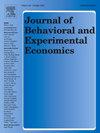7至9岁儿童的经济和身体冒险:与新奇驱动的探索策略的联系
IF 1.4
3区 经济学
Q2 ECONOMICS
Journal of Behavioral and Experimental Economics
Pub Date : 2025-06-06
DOI:10.1016/j.socec.2025.102397
引用次数: 0
摘要
冒险行为在不同领域的普遍化及其驱动力是当前争论的话题。这项研究调查了幼儿在经济和身体上的冒险行为。共有六十六个七到九岁的孩子被提出了两个计算机化的冒险任务,这些任务涉及不同的领域,即气球模拟风险任务(BART)中的经济损失和模拟交通任务(STT)中的身体伤害。我们的研究结果显示,在赌博任务中表现出最高风险倾向的孩子更有可能在模拟过马路任务中造成(假设的)事故。我们的研究结果还表明,在模拟过马路任务中使用新奇的、意想不到的车辆会增加儿童的身体风险。我们认为,探索性搜索策略作为一种近似机制,可以增加儿童的经济风险倾向和身体风险。本文章由计算机程序翻译,如有差异,请以英文原文为准。
Economic and physical risk-taking in 7- to 9-year-olds: The link with a novelty-driven exploratory strategy
The generalization of risk-taking behavior across different domains and the forces that drive it are current topics of debate. This study investigated economic and physical risk-taking in young children. A total of sixty 7- to 9-year-olds were presented with two computerized risk-taking tasks that tapped different domains, namely economic losses in the Balloon Analogue Risk Task (BART) and physical injury in the Simulated Traffic Task (STT). Our results revealed that the children who displayed the highest risk propensity in the gambling task were more likely to cause a (hypothetical) accident in the simulated street-crossing task. Our findings also showed that the use of novel, unexpected vehicles in the simulated street-crossing task increased physical risk-taking in children. We suggest that an exploratory search strategy functions as a proximate mechanism that increases both economic risk proneness and physical risk-taking in children.
求助全文
通过发布文献求助,成功后即可免费获取论文全文。
去求助
来源期刊
CiteScore
2.60
自引率
12.50%
发文量
113
审稿时长
83 days
期刊介绍:
The Journal of Behavioral and Experimental Economics (formerly the Journal of Socio-Economics) welcomes submissions that deal with various economic topics but also involve issues that are related to other social sciences, especially psychology, or use experimental methods of inquiry. Thus, contributions in behavioral economics, experimental economics, economic psychology, and judgment and decision making are especially welcome. The journal is open to different research methodologies, as long as they are relevant to the topic and employed rigorously. Possible methodologies include, for example, experiments, surveys, empirical work, theoretical models, meta-analyses, case studies, and simulation-based analyses. Literature reviews that integrate findings from many studies are also welcome, but they should synthesize the literature in a useful manner and provide substantial contribution beyond what the reader could get by simply reading the abstracts of the cited papers. In empirical work, it is important that the results are not only statistically significant but also economically significant. A high contribution-to-length ratio is expected from published articles and therefore papers should not be unnecessarily long, and short articles are welcome. Articles should be written in a manner that is intelligible to our generalist readership. Book reviews are generally solicited but occasionally unsolicited reviews will also be published. Contact the Book Review Editor for related inquiries.

 求助内容:
求助内容: 应助结果提醒方式:
应助结果提醒方式:


